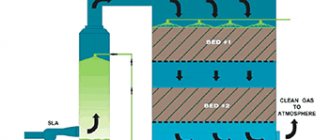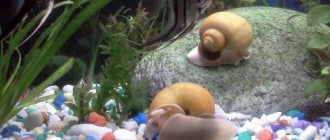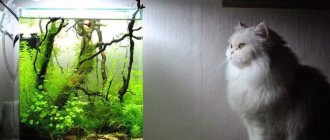It is not recommended to turn off the aquarium filter every night. The filter plays a key role in the health of your aquarium, and leaving it off for a few hours can eventually lead to problems.
Of course, you probably know that a filter removes debris from the water, such as uneaten and decaying food, fish waste, and dead plant matter. Getting that debris out of there is vital, but it's only one of the important tasks your filter performs.
Did you know that your aquarium contains colonies of bacteria that convert toxic chemicals in the water into harmless ones? This is known as the nitrogen cycle.
Your filter plays a key role in this process for two reasons. Firstly, the filter is one of the main places in your aquarium where microbial colonies thrive. Second, your filter helps aerate the water. Oxygen is very important in your aquarium, not only for the fish, but also for the microbes. Without this they would die.
Beginners in aquariums often install an air pump to create bubbles in their aquariums, believing that they are adding oxygen to the water. This will add some oxygen and usually won't hurt, but a good filter will circulate enough water to provide oxygen to the fish. If you turn off the filter and water no longer flows through the elements inside, you will deprive the microbes living there of the oxygen they need to survive.
Just like your fish, the microbes in your tank are quite hardy. Turning off the filter overnight every now and then won't hurt them. But if you do this every night, you're depriving your fish and microbes of oxygen for eight hours out of every twenty-four hours, and it will eventually catch up with them.
The final reason to leave your aquarium filter on at night has to do with what happens when you turn it back on. Depending on how long ago you cleaned them, some filters will return dirty water and debris back into your tank during the priming process.
If you go through this every morning, you're essentially dumping all the gunk your filter took out of the reservoir the day before right back. This is not only a good argument for keeping your filter running, but also for following proper tank maintenance practices.
Aquarium filter noise
If you're considering turning off your aquarium filter at night, I'll give you the benefit of the doubt and assume it's not because you want to create some kind of sadistic survival problem for your fish. Instead, I'm going to guess that it's because your filter is too noisy. There are several things you can do.
You'll want to find out whether the noise is caused by water movement or the mechanics of the filter itself. If it appears to be water movement, check the water level in the aquarium. Low water levels can cause a waterfall effect and increase gurgling sounds.
For most filters, you'll want the water level up to the edge of the filter outlet (be careful not to overfill the reservoir, of course). This allows the water to flow out smoothly without much turbulence. Some filters have an adjustment knob that allows you to change the flow rate, which can help reduce noise.
Sometimes the noise is caused by the filter components themselves. Most filters can be disassembled and cleaned. Sometimes dirt accumulates on the impeller or the impeller itself becomes damaged, causing a rattling noise. Sometimes dirt will prevent the plastic pipe pieces from fitting together correctly or connecting properly to the impeller section. This may cause rattling or grinding noise.
Keep these points in mind before messing with your filter:
- Always unplug your aquarium filter before cleaning or handling it. Always! You're working with water and electricity, and that's a bad combination.
- While this is probably obvious, if you are unsure, contact the manufacturer to find out which components can be taken apart.
- Disassembling the filter's electrical components is very dangerous and should never be attempted.
Error Change water
Change the water once a week!
To keep the inhabitants and vegetation in your aquarium healthy, it is necessary to carry out water changes correctly. It is absolutely not necessary to completely change all the water in the container. It is enough to replace a quarter or a third of the aquarium volume every week.
To do this, you can use cold tap water, which must be allowed to stand for at least a day. A good solution is to use water conditioners, which will make your tap water suitable for your aquarium. If there are no living plants in the vessel, you can clean the soil with a siphon at the same time as changing the water.
And remember! No matter how good the filter , changing the water still remains a prerequisite for caring for the aquarium! By doing this, you get rid of the waste products of living inhabitants, and also saturate the water with nutrients necessary for microorganisms and plants.
Is it possible to turn off the air pump at night?
This is not as big a problem as turning off the filter. If your air pump is driving you crazy, you can turn it off overnight while your filter runs and does its job.
But what if the air pump is your filter? Some of these small aquarium kits use an air pump with an air stone and tube and call it a filter. It is supposed to act as a sort of filter under the gravel. If your "filter" matches this description, it is actually an air pump. While it may not purify the water very well, it does keep the water moving and provide an oxygenating effect.
I have always found air pumps to be noisier and more abrasive than filters. But the good news is that besides choosing a different tank with a good filter, there are a few other things you can do.
- The first thing you might want to do is place something soft under the pump. Air pumps vibrate and often rattle when placed on a hard surface.
- You can also try placing the air pump in a box without a lid (the part without the lid is important, as you'll see shortly), which may help absorb some sounds.
- If you have an old air stone, consider replacing it. A clogged air stone makes the pump difficult to operate.
Caution: Although you may be tempted to do this, I do not recommend wrapping the air pump in a towel or similar item. Pumps generate some heat and it is important to let it dissipate. Otherwise, you could overheat the air pump or worse.
Design and principle of operation
Internal aqua cleaners have a fairly simple design. Each of them is a cylindrical body with slots for drawing in water, to which a small pump is attached.
Inside the housing is one or more filter media. In its simplest form, this material is foam rubber (elastic polyurethane foam).
Water, passing under pressure through the foam cells, gets rid of mechanical impurities and goes back into the aquarium. Colonies of saprophytes (microorganisms accumulating in foam cells) perform biological purification of aqua, turning decomposed organic matter into inorganic substances.
In appearance, the device resembles a glass. This is what owners of ornamental fish often call it.
Will your fish die if you turn off the filter?
Your fish probably won't die as a result of turning off the filter overnight. If they do, you have something else going on that is putting them in a weakened, unhealthy state.
It is also a misconception that turning off the filter for one night will kill all your healthy germs and you will have to restart the tank. These little microbes are tough.
However, if you make it a habit to turn off the filter every night, you will be putting your fish and microbial colonies in a bad situation. Filters not only remove waste from your tank, but also provide important aeration. Remove the filter from the equation a third of each day and your aquarium will eventually suffer.
Lifespan
The lifespan of aquarium fish depends on the conditions of care, proper nutrition and species characteristics. They live from 4 to 30 years. The table shows the average duration of popular types:
Large species and those that lay eggs live longer than viviparous and small fish.
Feeding
When feeding fish, the main rule is not to overfeed. Otherwise, the pets will quickly die. For most species, one meal per day is sufficient.
At first, accompany feeding with an action, for example, knocking on glass. Then a conditioned reflex is created. Feed at the same time every day. Diet requires variety and balance.
Aeration in the aquarium. I answer your questions
The main foods suitable for most aquarium fish are:
- artificial industrial feed;
- live or frozen bloodworms;
- vegetable feed;
- for predators: chopped meat or fish;
- finely chopped squid and shrimp;
- “live dust” for fry.
Alternate feeds. The size of a single serving will be determined by testing. The food must be eaten completely. Leftover food quickly begins to rot and pollutes the water. Therefore, remove any leftovers after feeding. It is beneficial for fish to fast once every two weeks.
Should it work constantly or not?
In an aquarium, the fish population density is many times higher than in open natural reservoirs.
In addition, rivers and lakes have a natural water purification system: part of the mineral pollution is carried away with the current, the other part is absorbed by plants. Thus, the natural reservoir independently maintains the purity of water for the normal life of its inhabitants. Artificial reservoirs lack such natural mechanisms and require the installation of additional water treatment equipment - filters.
Filters are used not only to preserve the beauty of the aquarium, but also to keep it clean.
Can I turn it off at night?
You should not leave the container without filtration overnight, even if the operation of the device interferes with sleep. Such a long and simple water purification will not have the best effect on the living conditions and well-being of the fish.
In what cases and for how long can I disable it?
The filter device can be deactivated only in 2 cases:
- When feeding dry food. Forage that does not immediately settle to the bottom, but floats in the water column and on its surface, is often sucked in by the filter device. To prevent this from happening, the filter can be turned off for 3-5 minutes while the fish is feeding. As soon as the fish has eaten everything, filtration must be restored immediately.
- While you are washing the filter. The filter device should be washed every 1-2 weeks. Of course, for these purposes the device is turned off.
You can keep the aquarium without filtration for more than 2 hours.
What can replace the cleaner?
An aquarium filter cannot be replaced by anything, since only specially manufactured devices are capable of efficiently purifying water and maintaining a closed system in biological balance.
There are a lot of instructions on the Internet for making external and internal filters with your own hands, but such a device is not able to offer 100% high quality, and most importantly, safely continuously purify aquarium water.
The only alternative to a filter is to organize the aquarium in such a way that the system itself is capable of processing harmful substances and preventing their accumulation. With a properly created biological balance, aquarium inhabitants can live a long life without a filter. It is only necessary to change some of the water in a timely manner.
The main nuances that will allow you to keep an aquarium without a filter for as long as possible:
A large number of plants. The ideal option would be elodea, fern, Vallisneria, Echinodorus, various mosses and ferns.- After planting the plants in the ground, you need to wait some time (about 2-3 weeks) until the biological balance appears, only then can you add fish.
- There should not be many residents; overpopulation should not be allowed.
- change 10% of the water once a week and water the soil.
- It is necessary to add crustaceans to the container, which naturally purify the water, as well as aquarium staff (shrimp, snails, ancistrus).
- Do not leave uneaten food after feeding.
When an aquarium filter suddenly goes out, everything must be done to preserve the life and health of the inhabitants of the aquarium. You should not intentionally turn off the filter too often, even for a short time - the device is designed for uninterrupted operation, and frequent stops lead to rapid failures.
Popular manufacturers
Some of the best manufacturers of internal filters for aquariums, according to professional aquarists, are:
- Tetra;
- Aquael;
- Sera.
Now let's talk in more detail about each manufacturer.
Aquael filters FAN series
This series is the simplest and most inexpensive, the operating principle is based on mechanical filtration, the country of origin is Poland. Suitable for aquariums from 3 to 250 liters. A novice aquarist can easily cope with installing and maintaining equipment.
There are five models of Aquael FAN series filters:
- FAN Micro. Used for cleaning aquariums whose volume is 0–30 liters, the maximum productivity of the model is 250 l/h.
- FAN Mini. Suitable for tanks from 30 to 60 liters. Maximum productivity - 260 l/h.
- FAN 1. Designed for aquariums with volumes from 60 to 100 liters. Maximum productivity - 340 l/h.
- FAN 2. Designed for aquariums with a volume of 100-150 liters. Maximum productivity - 450 l/h.
- FAN 3. Suitable for tanks whose volume varies from 150 to 250 liters. Maximum productivity - 700 l/h.
Sera
A German company producing equipment for aquariums and fish food. There are several types of Sera filters:
- The L series is designed for aquariums up to 300 liters. The equipment is airlift, powered by an air compressor;
- The F series is designed for tanks with volumes of 100, 150 and 300 liters. Mechanical water purifiers consist of a sponge and a pump;
- The fil series is suitable for containers with volumes up to 60 or 120 liters, respectively. Filter material activated carbon and sponge.
Tetra
Another German brand that has proven itself well among amateur and professional aquarists. Tetra produces the following filter models:
- EasyCrystal with combined filtration. Designed for tanks up to 40, 60 and 130 liters;
- IN plus. The series provides biological and mechanical water purification. There are two cleaning chambers, used in aquariums with volumes up to 60, 100, 150 and 200 liters;
- Filter Jet - the simplest mechanical filtration in aquariums from 50 to 120 liters, 120-170 liters, 170-230 liters;
- BrillantFilter, powered by a compressor. Designed to work in containers up to 100 liters.
Is it possible to overdo filtering?
It is impossible to overdo it with filtration, but using a powerful filter designed for a much larger volume in a small aquarium will lead to the formation of a strong flow of water. Some fish, such as the fast-swimming zebrafish, can thrive in the water. However, others, such as Siamese fighting cocks, can become tired and even die if the water is constantly moving. Once you have decided on the size of aquarium you need, you can consult an expert at your pet store for advice on choosing the right filter.











